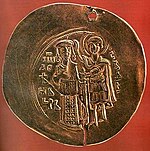
Back العملات البلغارية في العصور الوسطى Arabic Средновековни български монети Bulgarian Средневековые болгарские монеты Russian Srednjeveški bolgarski kovanci Slovenian Monedhë bullgare mesjetare Albanian

Medieval Bulgarian coinage were the coins minted by the Bulgarian Emperors during the Middle Ages at the time of the Second Bulgarian Empire.
There is no evidence that coins were minted during the First Bulgarian Empire, and minting ceased after the fall of the Second Empire with Ottoman domination in 1396. They were gold (perperi), silver (aspri), billon (coinage of silver and copper) and copper coins, all flat and hollow. The inscriptions were usually in Bulgarian language and rarely in Greek. Due to the limited space the inscriptions were abbreviated, often written with a few letters and special signs. Artistically, they continued the Byzantine numismatic tradition but the designs were often more schematic. The main means of expression were lines and dots. The Bulgarian coins had images different from the Byzantine and Slav coinage, so they form a distinct group. The coins are an important source for the history of the Second Bulgarian Empire.